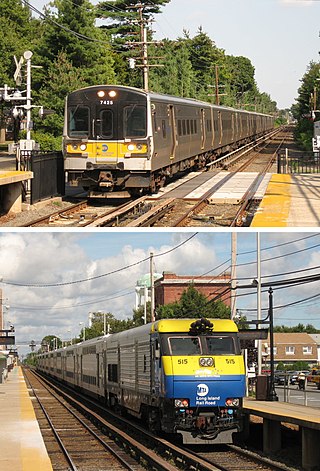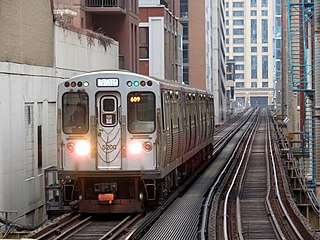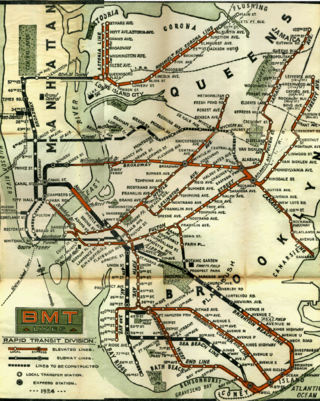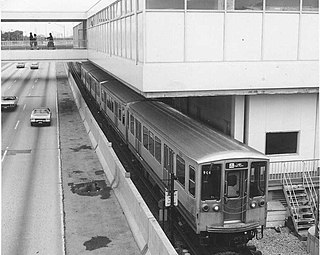
The Long Island Rail Road, often abbreviated as the LIRR, is a railroad in the southeastern part of the U.S. state of New York, stretching from Manhattan to the eastern tip of Suffolk County on Long Island. The railroad currently operates a public commuter rail service, with its freight operations contracted to the New York and Atlantic Railway. With an average weekday ridership of 354,800 passengers in 2016, it is the busiest commuter railroad in North America. It is also one of the world's few commuter systems that runs 24/7 year-round. It is publicly owned by the Metropolitan Transportation Authority, which refers to it as MTA Long Island Rail Road. In 2023, the system had a ridership of 75,186,900, or about 276,800 per weekday as of the first quarter of 2024.

The Green Line is a rapid transit line in Chicago, Illinois, operated by the Chicago Transit Authority (CTA) as part of the Chicago "L" system. It is the only completely elevated route in the "L" system. All other routes may have various combinations of elevated, subway, street level, or freeway median sections.

The IRT Ninth Avenue Line, often called the Ninth Avenue Elevated or Ninth Avenue El, was the first elevated railway in New York City. It opened in July 1868 as the West Side and Yonkers Patent Railway, as an experimental single-track cable-powered elevated railway from Battery Place, at the south end of Manhattan Island, northward up Greenwich Street to Cortlandt Street. By 1879 the line was extended to the Harlem River at 155th Street. It was electrified and taken over by the Interborough Rapid Transit Company in 1903.

The Market–Frankford Line (MFL), currently rebranding as the L, is a rapid transit line in the SEPTA Metro network in Philadelphia, Pennsylvania, United States. The MFL runs from the 69th Street Transportation Center in Upper Darby, just outside of West Philadelphia, through Center City Philadelphia to the Frankford Transportation Center in Near Northeast Philadelphia. Starting in 2024, the line was rebranded as the "L" as part of the implementation of SEPTA Metro, wherein line names are simplified to a single letter.

The BMT Lexington Avenue Line was the first standard elevated railway in Brooklyn, New York, operated in its later days by the Brooklyn Rapid Transit Company, the Brooklyn–Manhattan Transit Corporation, and then the City of New York.

The BMT Franklin Avenue Line is a lower capacity rapid transit line of the New York City Subway in Brooklyn, New York, running between Franklin Avenue and Prospect Park. Service is full-time, and provided by the Franklin Avenue Shuttle. The line serves the neighborhoods of Bedford-Stuyvesant and Crown Heights, and allows for easy connections between the Fulton Street Line and the Brighton Line.
The New York and Putnam Railroad, nicknamed the Old Put, was a railroad line that operated between the Bronx and Brewster in New York State. It was in close proximity to the Hudson River Railroad and New York and Harlem Railroad. All three came under ownership of the New York Central system in 1894. The railroad was abandoned starting in 1958, and most of the former roadbed has been converted to rail trail use.

The South Brooklyn Railway is a railroad in the New York City borough of Brooklyn. It is owned by the government of New York City and operated by the New York City Transit Authority. Its original main line ran parallel to 38th Street from the Upper New York Bay to McDonald Avenue, and south on McDonald Avenue to the Coney Island Yards, mostly underneath the former Culver Shuttle and the IND Culver Line of the New York City Subway.
Railroad electrification in the United States began at the turn of the 20th century and comprised many different systems in many different geographical areas, few of which were connected. Despite this situation, these systems shared a small number of common reasons for electrification.

The New York, Westchester and Boston Railway Company, was an electric commuter railroad in the Bronx and Westchester County, New York from 1912 to 1937. It ran from the southernmost part of the South Bronx, near the Harlem River, to Mount Vernon with branches north to White Plains and east to Port Chester. From 1906, construction and operation was under the control of the New York, New Haven & Hartford Railroad (NH) until its bankruptcy in 1935.
The 129th Street station was a transfer station on the IRT Third Avenue Line in Manhattan, New York City, shared by elevated trains of both the Third Avenue Line and IRT Second Avenue Line. The next stop to the north was 133rd Street for the main line and Willis Avenue for the Willis Avenue spur, both of which were across a swing bridge above the Harlem River in the Bronx. The next stop to the south was 125th Street−Third Avenue for Third Avenue Line trains and 125th Street−Second Avenue for Second Avenue Line trains.

The Northwestern Elevated Railroad was the last of the privately constructed rapid transit lines to be built in Chicago. The line ran from the Loop in downtown Chicago north to Wilson Avenue in Chicago's Uptown neighborhood with a branch to Ravenswood and Albany Park that left the main line at Clark Street. The Ravenswood line is now operated as the Brown Line, while the Main Line is used by the Purple and Red Lines.

The Kaufman Electrification Act of 1923, or Kaufman Act for short, was a law passed by the New York State Legislature, mandated electrification of all railroads in New York City by January 1, 1926. The bill was sponsored by recently elected Republican Assemblyman Victor R. Kaufman and signed by Governor Al Smith on June 2, 1923.

The Lake–Dan Ryan Line was a rail rapid transit route formerly operated by the Chicago Transit Authority (CTA). The Lake–Dan Ryan Line existed from the opening of the Dan Ryan branch on September 28, 1969, until February 21, 1993. When created, the route united two transit corridors that until 1969 never had through rail service. This routing, which became known as the West-South route, operated from the Harlem terminal in Forest Park on the Lake Street "L" through downtown Chicago along the Union Loop "L", and then via the old South Side "L" and the new Dan Ryan Line to the 95th Street Terminal. The Lake–Dan Ryan service was planned in conjunction with the former Franklin Street Connector and Chicago Central Area Transit Project, both of which were never constructed. The section of the route between the junction with the South Side "L" at 17th and State Streets and the Cermak–Chinatown Station was originally an "interim", or temporary facility. It was planned to be torn down when the Loop Subway system was completed, but survived after the project was canceled in 1979. That section was improved in the 1980s and early 1990s and is currently being used by the Orange Line. Train transfers are possible by using the two unused tracks.
The Willis Avenue station was an elevated rapid transit station of the Willis Avenue Spur that branched off of the IRT Third Avenue Line in the Bronx, New York City. It opened in 1886 and closed in 1924.











